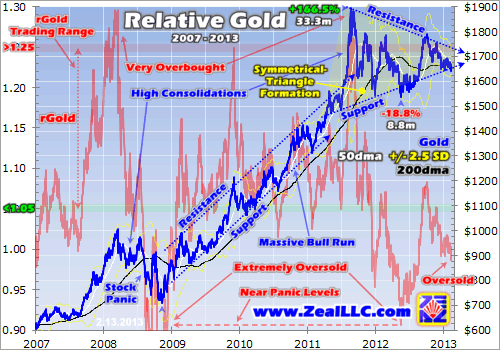As I’m putting the final touches on this Market Report, the prices are again under pressure.
Another attack without any fundamental logic is happening on the paper markets for gold and silver, markets that have become unreal and fictitious.
This price consolidation that has been going on for 18 months, and that resembles a lot the one that happened in 2007-2008, is making certain investors nervous. Which is understandable, given the duration of this consolidation, but nothing has changed for the market fundamentals. On the contrary, more and more elements plead in favor of a new phase of growth for gold and silver prices.
Egon von Greyerz, board member of Goldbroker.com, was saying recently that the real bull market in gold hadn’t started yet, despite 13 years of continued performance. Read his explanations here and here

Investing in the actual context is delicate and psychologically difficult, because we are in a unique situation. We’re at the end of a super-cycle of debt and at the end of a monetary experiment that started with the end of convertibility into gold and, thus, we’re in a full transition phase toward a new monetary system.
Protecting one’s savings has become even more difficult because of all the disinformation and the manipulations that give false readings of the traditional indicators, which are now obsolete.
Therefore, we have to look at the big picture, because there are still trustworthy indicators that do not fool the gold market specialists and that counter the rantings of the pseudo-economists, financial advisors, bankers and media announcing the end of the gold bull market.
As an aside, those people are the ones that have hindered 13 years of continued performance of the precious metals... performance that could have multiplied the capital of millions of investors. As a reminder, gold and silver have been the best financial assets for the last ten years.
Instead, the percentage of the world population under the threshold of poverty, on food stamps, or having lost some or all of their savings (market crash, real estate crash, inflation) has exploded.
So, it’s almost comical to hear them talk today about the end of the gold bull market... It should give us an idea as to what interests they’re defending, really. Certainly not those of investors and savers, in my opinion. (One can analyse this disinformation in relation to point 4, regarding a silent gold rush)
Therefore, one cannot trust the dominant discourse when one wants to protect one’s savings appropriately.
Most investors don’t realize this, but they’re in the middle of the battlefield of the global currency war. Surviving in this context is difficult, and precious metals, which have been the best safe haven assets for ten years, are sometimes under pressure. It’s such a case with this consolidation phase. Earning money, or just protecting one’s savings, has never been easy : it requires financial know-how and patience at this moment, but the gold bull market is far from over. (Click here to see my video interview with Egon von Greyerz)
1) The last G-20 summit only confirmed the continuation of monetary printing policies and the kicking of the can down the road. We can only conclude from this summit that Japan has been authorized to accelerate the devaluation of the yen. What was announced is in complete contradiction with the reality of a global currency war which drags all currencies to the bottom and brings us dangerously close to hyperinflation.
The Fed continues to print $85B a month to buy back worthless assets and to finance the US government’s deficit. We now see that exponential monetary printing, for financing the States’ deficits, has become global.
All currencies are failing, at different speeds, and so it seems important to hide or manipulate the real inflation indicator (gold) in order to keep the masses from connecting the dots between monetary policies, inflation, and the generalized impoverishment due to the loss of purchasing power.
The number of people on food stamps in the USA has just surpassed the 50-million level.
2) Gold is in backwardation again, since the end of January, which means that major investors are not selling their physical gold, even though they could pocket some easy profits by selling today at spot price and by buying back cheaper via a short-term (a few months) future contract. Read "Gold in Backwardation Again !" by Philippe Herlin
The fact that those investors, whom we could call insiders, are not selling when everything is done, through manipulation on the COMEX, to bring prices down, is revealing. They don’t want to sell at an artificially low price. They are thus well aware, as are more and more investors, that the spot « paper » price is manipulated and fictitious, and that it does not reflect in any way the true value of physical gold.
Trust in the way the price of gold is determined is waning.
This trend has to be seen in the light of the gold repatriation phenomenon by the States and of the silent gold rush, as noted in point 5), further down.
One may ask, why are the countries repatriating an asset that’s described by the media as a « barbarous relic » ?
The most stunning example to date : Germany will have to wait seven years to repatriate a small part of the gold that it owns (in theory). There is no logical justification for such a delay for so small an amount but the possibility that the gold doesn’t exist anymore, that it’s been leased in the market by those who are supposed to store it, in order to manipulate the prices down.
3) The central banks haven’t bought that much gold since 1964 : why are central banks buying so much gold ? Are they anticipating a coming evolution of the international monetary system ?
Jim Sinclair, legendary investor, brings us an answer this week, by explaining that we are in a global gold revaluation process, and that gold will form the base of the future monetary system, because it’s the only internationally recognized trustworthy asset/collateral. We are fully in a transition phase toward this system, and a means to protect one’s capital in these times is to be invested in physical gold.
The major problem today is that there is no trustworthy standard, no solid collateral to really repay, or « kill » a debt.
Today, government debts are reimbursed by the issuing of more debt... they’re never « killed ». Governments, central banks and investors are holding assets that are based on debt in a way or another, or on debt on debt, via financial products that more and more people distrust.
Gold, when it’s revalued, will help in solving debts. According to Jim Sinclair, it’s the Golden End Game, which will let us start afresh from zero, and on sound bases.
This is the monetary solution that will be used in replacement of the quantitative easing (QE) programs, as was done in 1934.
However, contrary to 1934, there will be no gold confiscation because nobody really holds any gold... the average investors do not hold gold like they did in the '30s, so there is not much gold to confiscate.
4) Gold is oversold and is consolidating on its highs : Adam Hamilton, an analyst and gold trader for ten years, who had predicted a consolidation in gold in August 2011, just turned bullish on gold, based on an indicator he’s following, the Relative Gold Index :

This indicator is in oversold territory and just reached levels close to those at the end of 2008, just before the gold price started a +166.5% run in 33.3 months. This indicator being oversold at the time the price is consolidating on the highest highs of 13 years is very positive for the future evolution of the gold price.
Technically (see chart), Adam Hamilton is saying that we’ve been out of the consolidation phase since May 2012, and that the bull market has resumed.
Adam Hamilton also reminds us that the mortal enemy of investors is emotion. Greed leads investors to buy high, and fear leads them to sell low. Which is exactly contrary to what should be done in order to multiply one’s capital. To avoid this, one has to put things in perspective, which I’ve just done by recalling some of the trustworthy fundamentals and indicators.
5) A Silent Gold Rush : James Corbett, in an excellent short piece, explains that the actual gold rush is a silent one. This could be the most importan point to understand, in my opinion :
The central banks know what’s happening. They know perfectly well that we’re living a monetary experiment akin to a worldwide Ponzi scheme that will end, like all Ponzi schemes, in a monetary shipwreck (hyperinflation, certainly).
Central banks are aware of the generalized devaluation of currencies that helps countries being temporarily more competitive on the markets, and that helps also to lessen the burden of their debts.
They know that the amount of physical gold available is largely inferior to the quantity of paper gold sold on the markets, and that this « paper » gold constitutes a promise on delivery of non-existent gold.
They know that the gold market is a gigantic game of musical chairs, as I’m explaining here, and that the music (trust in the paper market) is going to stop abruptly.
For all these reasons, they’re buying as much gold as they can, while being as discreet as possible (like China, that does not publish its official gold reserves), in order to avoid a physical gold rush that would dry up the market.
The central banks don’t want to be caught without a chair when the music stops. Neither do the States and the insider investors.
Reproduction, in whole or in part, is authorized as long as it includes all the text hyperlinks and a link back to the original source.
The information contained in this article is for information purposes only and does not constitute investment advice or a recommendation to buy or sell.

















